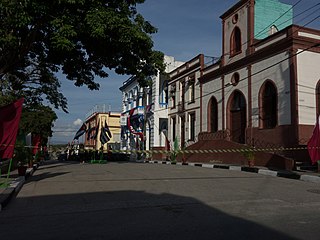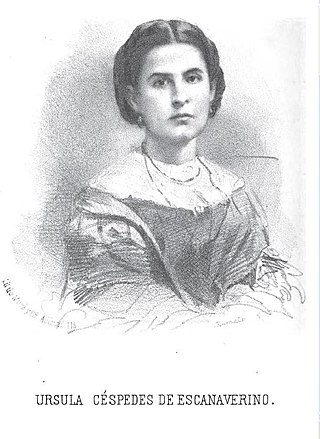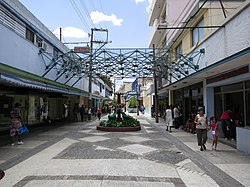
The national flag of Cuba consists of five alternating stripes and a red equilateral triangle at the hoist, within which is a white five-pointed star. It was designed in 1849 and officially adopted May 20, 1902. The flag is referred to as the Estrella Solitaria, or the Lone Star flag. It is in the stars and stripes flag family.

Trinidad is a town in the province of Sancti Spíritus, central Cuba. Together with the nearby Valle de los Ingenios, it has been a UNESCO World Heritage Site since 1988, because of its historical importance as a center of the sugar trade in the 18th and 19th centuries. Trinidad is one of the best-preserved cities in the Caribbean from the time when the sugar trade was the main industry in the region.

The Ten Years' War, also known as the Great War and the War of '68, was part of Cuba's fight for independence from Spain. The uprising was led by Cuban-born planters and other wealthy natives. On 10 October 1868, sugar mill owner Carlos Manuel de Céspedes and his followers proclaimed independence, beginning the conflict. This was the first of three liberation wars that Cuba fought against Spain, the other two being the Little War (1879–1880) and the Cuban War of Independence (1895–1898). The final three months of the last conflict escalated with United States involvement, leading to the Spanish–American War.

Sancti Spíritus is a municipality and capital city of the province of Sancti Spíritus in central Cuba and one of the oldest Cuban European settlements. Sancti Spíritus is the genitive case of Latin Sanctus Spiritus.

Manzanillo is a municipality and city in the Granma Province of Cuba. By population, it is the 14th-largest Cuban city and the most populated one not being a provincial seat.

Palma Soriano is a Cuban city and municipality in the Santiago de Cuba Province. With a population of 119,740 in the city proper, it is the second-largest in the province and the 16th-largest in Cuba.

Las Tunas is a city and municipality in central-eastern Cuba. It is the capital of the Las Tunas Province and was named Victoria de Las Tunas from 1869 to 1976.

Yara is a small town and municipality in the Granma Province of Cuba, located halfway between the cities of Bayamo and Manzanillo, in the Gulf of Guacanayabo. Yara means "place" in the Taíno language.

Florida is a municipality and city in the Camagüey Province of Cuba. It is located 40 km (25 mi) north-west of Camagüey, along the Carretera Central highway. The city was established in 1907, and the municipality was established in 1924. Of all the municipalities of the Cuban province of Camagüey, Florida is third in area size. The name is Spanish for Land of flowers.

Alazanes de Granma is a baseball team in the Cuban National Series, based in the eastern province of Granma. Until the 2016-2017 season, the Alazanes were a frequent contender, but had never advanced to a National Series final. However, in 2017 Granma not only made it to the Cuban National Series final, but swept Ciego de Ávila to win the series, breaking a 40-year record of being seen as underdogs who could not compete with dominant powerhouse teams.

Francisco Vicente Aguilera was a Cuban patriot born in Bayamo, Cuba on June 23, 1821. He had ten children with his wife Ana Manuela Maria Dolores Sebastiana Kindelan y Sanchez. He studied at the University of Havana receiving the degree of Bachelor of Laws.
Carlos Manuel de Céspedes Airport is a regional airport serving the city of Bayamo in the Granma Province of Cuba. It is named for Carlos Manuel de Céspedes.

Urbano Noris is a municipality and city in the Holguín Province of Cuba. The municipal seat is located in the town of San Germán.

Buey Arriba is a municipality and town in the Granma Province of Cuba. It is located 30 kilometres (19 mi) south of Bayamo, the provincial capital.

Cauto Cristo is a municipality and town in the Granma Province of Cuba. It is located on the banks of the Río Cauto, in the western part of the province, bordering the provinces of Holguín and Las Tunas.

Río Cauto is a municipality and town in the Granma Province of Cuba. It is located in the northern part of the province, upstream of the mouth of Cauto River.

Bartolomé de Jesús Masó Márquez was a Cuban politician and military, patriot for Cuban independence from the colonial power of Spain, and later President of the República en Armas.

Úrsula Céspedes was a Cuban poet and founder of the Academia Santa Úrsula in Manzanillo, Cuba, originally from Bayamo, Cuba.

The Circuito Sur de Oriente (CSO), meaning "Southern Circuit of the Orient", is a west-east highway connecting Bayamo to Santiago de Cuba, through Manzanillo, Niquero and the southern coastal side of eastern Cuba, below the Sierra Maestra mountain range. Also known as Circuito Guacanayabo-Sur de Oriente, because it crosses the Gulf of Guacanayabo, the name Oriente, refers to the ancient and former Oriente Province. With a length of 347 km, it is the fourth-longest Cuban highway after the "Carretera Central", the "Circuito Norte" and the "Circuito Sur".

The Battle of Peralejo was a military confrontation between Cuban independence rebels, under the command of Major General Antonio Maceo against the forces of the Spanish Army, under the command of Captain General Arsenio Martínez Campos, which was part of Maceo's First Eastern Campaign during the Cuban War of Independence.























